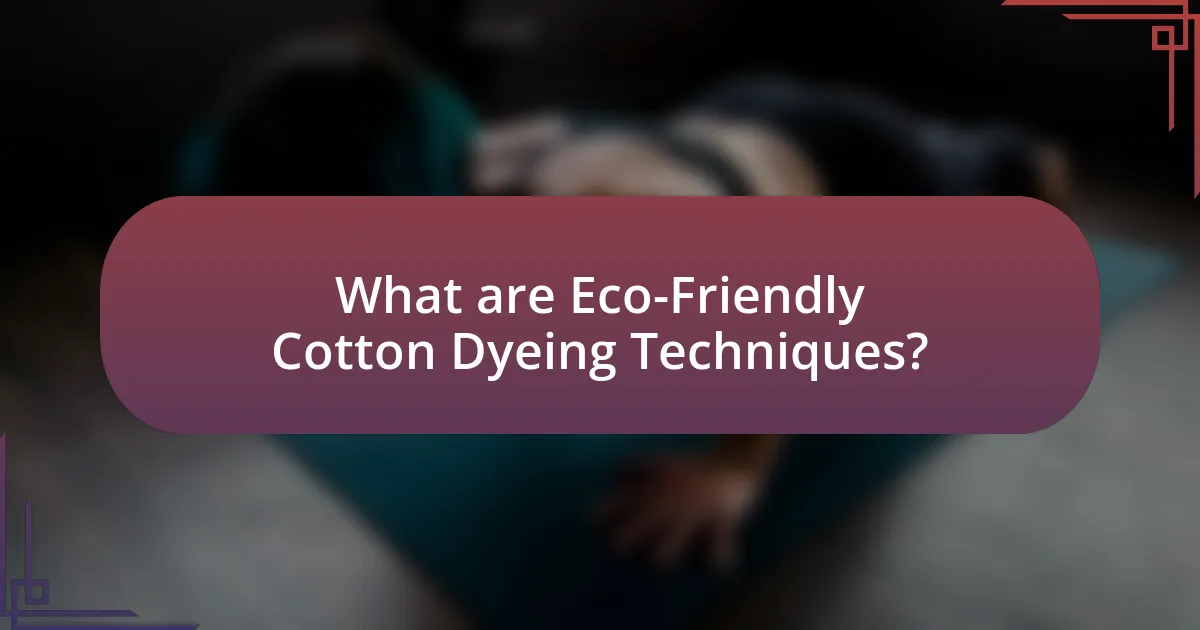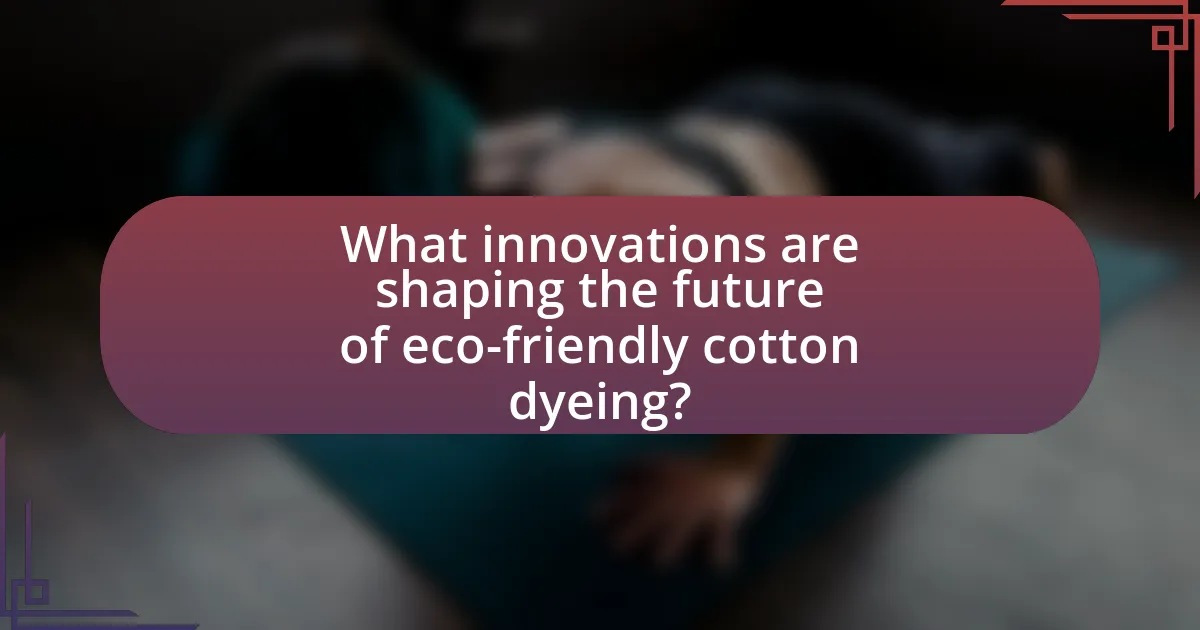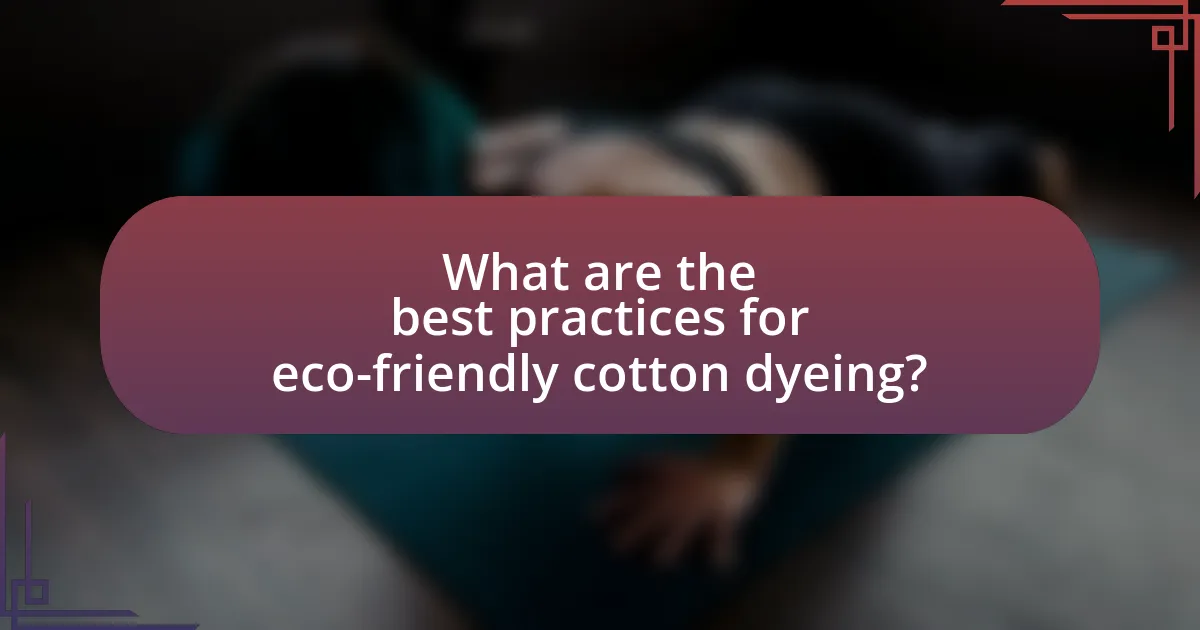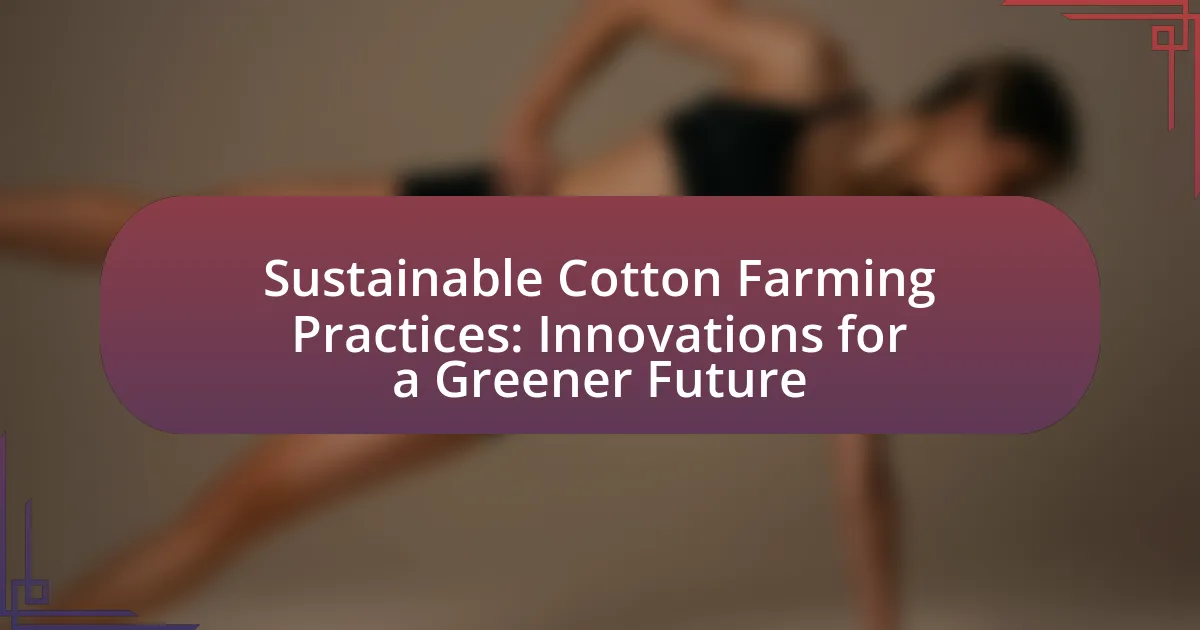Eco-friendly cotton dyeing techniques encompass sustainable methods such as natural dyeing, low-impact synthetic dyes, and waterless dyeing processes. These techniques significantly reduce environmental impacts by minimizing water usage, energy consumption, and chemical waste compared to traditional dyeing methods. The article explores the differences between eco-friendly and conventional practices, the materials used, and the importance of sustainability in the cotton dyeing industry. It also highlights innovations shaping the future of dyeing, the challenges faced in implementing these techniques, and best practices for manufacturers to ensure compliance with eco-friendly standards.

What are Eco-Friendly Cotton Dyeing Techniques?
Eco-friendly cotton dyeing techniques include methods such as natural dyeing, low-impact synthetic dyes, and waterless dyeing processes. Natural dyeing utilizes plant-based materials, minerals, or insects to create colors, significantly reducing environmental impact compared to conventional chemical dyes. Low-impact synthetic dyes are designed to require less water and energy during the dyeing process, while also minimizing harmful waste. Waterless dyeing techniques, such as digital printing and supercritical CO2 dyeing, eliminate the need for water altogether, further decreasing pollution and resource consumption. These methods collectively contribute to a more sustainable textile industry by reducing chemical usage and conserving water resources.
How do these techniques differ from traditional dyeing methods?
Eco-friendly cotton dyeing techniques differ from traditional dyeing methods primarily in their use of sustainable materials and processes that minimize environmental impact. Traditional dyeing often relies on synthetic dyes and harmful chemicals, which can pollute water sources and harm ecosystems. In contrast, eco-friendly techniques utilize natural dyes derived from plants, minerals, or other organic sources, reducing toxicity and waste. For example, methods such as waterless dyeing and low-impact dyes significantly lower water consumption and energy use compared to conventional practices, which can consume thousands of liters of water per kilogram of fabric dyed. This shift not only promotes sustainability but also aligns with growing consumer demand for environmentally responsible products.
What environmental impacts are reduced by using eco-friendly techniques?
Eco-friendly techniques significantly reduce water pollution, energy consumption, and waste generation in the cotton dyeing industry. Traditional dyeing methods often release harmful chemicals into water bodies, whereas eco-friendly alternatives utilize natural dyes and non-toxic processes, minimizing toxic effluent. For instance, a study by the Textile Research Journal found that using natural dyes can reduce water pollution by up to 90% compared to synthetic dyes. Additionally, eco-friendly techniques often employ energy-efficient processes, leading to a reduction in greenhouse gas emissions. By adopting these methods, the cotton dyeing industry can substantially lessen its environmental footprint.
What materials are commonly used in eco-friendly cotton dyeing?
Eco-friendly cotton dyeing commonly utilizes natural dyes derived from plants, minerals, and insects. For instance, indigo from the indigo plant, madder root for red hues, and turmeric for yellow are frequently employed. These materials are preferred due to their biodegradable nature and lower environmental impact compared to synthetic dyes, which often contain harmful chemicals. Research indicates that natural dyes can significantly reduce water pollution and energy consumption in the dyeing process, making them a sustainable choice for the textile industry.
Why is sustainability important in the cotton dyeing industry?
Sustainability is crucial in the cotton dyeing industry because it minimizes environmental impact and promotes resource conservation. The dyeing process traditionally consumes large amounts of water and energy while generating significant wastewater and chemical pollutants. For instance, the World Bank estimates that textile dyeing is responsible for 20% of global industrial water pollution. By adopting sustainable practices, such as using natural dyes and water-efficient technologies, the industry can reduce its ecological footprint and enhance the quality of water resources. Furthermore, sustainable practices can lead to improved economic outcomes for producers by meeting the growing consumer demand for eco-friendly products, thereby fostering a more responsible and resilient industry.
How does the cotton dyeing process contribute to environmental degradation?
The cotton dyeing process contributes to environmental degradation primarily through the release of toxic chemicals and excessive water consumption. During dyeing, synthetic dyes and harmful substances such as heavy metals and azo dyes are often used, which can contaminate water sources when wastewater is improperly treated or discharged. According to the World Bank, textile dyeing is responsible for 20% of global industrial water pollution. Additionally, the process typically requires large volumes of water, leading to depletion of local water resources and affecting ecosystems. The environmental impact is further exacerbated by the energy-intensive nature of dyeing, contributing to greenhouse gas emissions.
What role does consumer demand play in promoting sustainable practices?
Consumer demand significantly drives the adoption of sustainable practices by influencing production methods and corporate strategies. When consumers prioritize eco-friendly products, companies respond by integrating sustainable practices into their operations, such as adopting innovative cotton dyeing techniques that minimize environmental impact. For instance, a study by Nielsen found that 66% of global consumers are willing to pay more for sustainable brands, demonstrating that consumer preferences can lead to increased investment in sustainable technologies and practices within the textile industry. This shift not only promotes environmental responsibility but also encourages companies to innovate and improve their sustainability efforts to meet market expectations.

What innovations are shaping the future of eco-friendly cotton dyeing?
Innovations shaping the future of eco-friendly cotton dyeing include the use of natural dyes, waterless dyeing technologies, and digital printing methods. Natural dyes, derived from plants and minerals, reduce reliance on synthetic chemicals, promoting sustainability. Waterless dyeing technologies, such as supercritical CO2 dyeing, significantly minimize water usage, with some methods using up to 90% less water than traditional processes. Digital printing allows for precise application of dyes, reducing waste and enabling on-demand production, which further decreases environmental impact. These advancements collectively contribute to a more sustainable cotton dyeing industry by lowering water consumption, reducing chemical usage, and minimizing waste.
How are new technologies improving dyeing processes?
New technologies are improving dyeing processes by enhancing efficiency, reducing water usage, and minimizing environmental impact. For instance, digital printing technology allows for precise application of dyes, which significantly cuts down on water consumption by up to 90% compared to traditional methods. Additionally, innovations such as waterless dyeing techniques, like supercritical CO2 dyeing, eliminate the need for water altogether, further decreasing the ecological footprint of dyeing operations. These advancements not only streamline production but also align with sustainability goals in the textile industry, as evidenced by the increasing adoption of such technologies among manufacturers seeking eco-friendly solutions.
What are the benefits of using natural dyes in cotton dyeing?
The benefits of using natural dyes in cotton dyeing include environmental sustainability, safety for human health, and biodegradability. Natural dyes are derived from plants, minerals, and insects, which reduces reliance on synthetic chemicals that can harm ecosystems. Studies show that natural dyes often have lower toxicity levels compared to synthetic alternatives, making them safer for workers and consumers. Additionally, natural dyes are biodegradable, meaning they break down more easily in the environment, reducing pollution and waste. This aligns with the growing demand for eco-friendly practices in the textile industry, promoting a more sustainable approach to cotton dyeing.
How does waterless dyeing technology work?
Waterless dyeing technology works by utilizing advanced methods such as supercritical carbon dioxide (CO2) or digital printing to apply dyes to fabrics without the use of water. This technology replaces traditional dyeing processes that require large volumes of water, significantly reducing water consumption and pollution. For instance, supercritical CO2 dyeing uses CO2 in a supercritical state to dissolve dyes, allowing them to penetrate the fabric effectively while eliminating the need for water. Studies indicate that this method can reduce water usage by up to 90% compared to conventional dyeing techniques, making it a more sustainable option for the textile industry.
What are the challenges faced in implementing eco-friendly techniques?
The challenges faced in implementing eco-friendly techniques include high initial costs, limited availability of sustainable materials, and the need for specialized training. High initial costs can deter businesses from adopting eco-friendly practices, as they often require significant investment in new technologies and processes. Limited availability of sustainable materials, such as organic dyes and eco-friendly fabrics, can hinder the ability to fully transition to environmentally friendly methods. Additionally, the need for specialized training means that workers must be educated on new techniques and practices, which can be time-consuming and resource-intensive. These factors collectively create barriers to the widespread adoption of eco-friendly techniques in industries like cotton dyeing.
What economic factors influence the adoption of sustainable dyeing methods?
The economic factors influencing the adoption of sustainable dyeing methods include production costs, market demand, and regulatory incentives. Production costs are critical as sustainable dyeing methods often require higher initial investments in technology and materials, which can deter manufacturers. Market demand plays a significant role; as consumers increasingly prefer eco-friendly products, brands are incentivized to adopt sustainable practices to remain competitive. Regulatory incentives, such as subsidies or tax breaks for environmentally friendly practices, can also encourage the transition to sustainable dyeing methods. For instance, a report by the Ellen MacArthur Foundation highlights that companies adopting sustainable practices can benefit from reduced operational costs and improved brand loyalty, reinforcing the economic viability of such methods.
How can the industry overcome resistance to change?
The industry can overcome resistance to change by implementing comprehensive education and training programs that highlight the benefits of eco-friendly practices. These programs can demonstrate how sustainable cotton dyeing techniques not only reduce environmental impact but also enhance brand reputation and consumer loyalty. For instance, a study by the Textile Exchange found that brands adopting sustainable practices saw a 20% increase in customer engagement. By showcasing successful case studies and providing hands-on training, the industry can effectively shift mindsets and encourage the adoption of innovative, eco-friendly dyeing methods.

What are the best practices for eco-friendly cotton dyeing?
The best practices for eco-friendly cotton dyeing include using natural dyes, minimizing water usage, and employing sustainable dyeing techniques. Natural dyes, derived from plants, minerals, or insects, reduce the environmental impact compared to synthetic dyes, which often contain harmful chemicals. Minimizing water usage can be achieved through techniques such as dyeing in closed-loop systems, which recycle water, or using dry dyeing methods like supercritical CO2 dyeing. Additionally, utilizing low-impact dyes that require less energy and produce less waste further enhances sustainability. These practices collectively contribute to a reduced ecological footprint in the cotton dyeing process.
How can manufacturers ensure compliance with eco-friendly standards?
Manufacturers can ensure compliance with eco-friendly standards by implementing sustainable practices throughout their production processes. This includes using non-toxic dyes, reducing water consumption, and minimizing waste through recycling and reusing materials. For instance, the Global Organic Textile Standard (GOTS) provides a framework that manufacturers can follow to certify their products as organic and eco-friendly, ensuring adherence to environmental and social criteria. Additionally, manufacturers can conduct regular audits and assessments to monitor compliance with these standards, thereby reinforcing their commitment to sustainability in the cotton dyeing industry.
What certifications should be pursued for sustainable dyeing practices?
Certifications that should be pursued for sustainable dyeing practices include Global Organic Textile Standard (GOTS), OEKO-TEX Standard 100, and Cradle to Cradle Certified. GOTS ensures that textiles are made from organic fibers and meet environmental and social criteria throughout the supply chain. OEKO-TEX Standard 100 certifies that textiles are free from harmful substances, promoting safety for consumers and the environment. Cradle to Cradle Certified focuses on the entire lifecycle of a product, ensuring it is safe for human health and the environment while promoting circular economy principles. These certifications provide a framework for sustainable practices in the dyeing industry, ensuring compliance with environmental standards and consumer safety.
How can companies measure the effectiveness of their eco-friendly initiatives?
Companies can measure the effectiveness of their eco-friendly initiatives by utilizing key performance indicators (KPIs) such as reduction in carbon emissions, water usage, and waste generation. For instance, a study by the Carbon Trust found that companies implementing eco-friendly practices can reduce their carbon footprint by up to 30%, demonstrating significant environmental impact. Additionally, companies can conduct lifecycle assessments (LCAs) to evaluate the environmental effects of their products from production to disposal, providing concrete data on sustainability improvements. Tracking customer feedback and market share growth in response to eco-friendly initiatives also serves as a measure of effectiveness, as consumers increasingly prefer sustainable products.
What practical tips can be applied for sustainable cotton dyeing?
Practical tips for sustainable cotton dyeing include using natural dyes derived from plants, minerals, or insects, which reduce reliance on synthetic chemicals. Additionally, employing low-water dyeing techniques minimizes water usage, addressing the significant water consumption associated with traditional dyeing processes. Implementing closed-loop systems can further enhance sustainability by recycling water and chemicals, thereby reducing waste. Furthermore, selecting organic cotton ensures that the raw material is grown without harmful pesticides, contributing to a more eco-friendly dyeing process. Research indicates that natural dyes can be as effective as synthetic ones, providing vibrant colors while being less harmful to the environment.
How can small businesses implement eco-friendly dyeing techniques effectively?
Small businesses can implement eco-friendly dyeing techniques effectively by adopting natural dyes, utilizing water-efficient processes, and investing in sustainable materials. Natural dyes, derived from plants, minerals, and insects, reduce chemical waste and are biodegradable, making them a safer alternative to synthetic dyes. For instance, studies show that natural dyes can significantly lower environmental impact, as they often require less water and energy during production.
Additionally, small businesses can adopt water-efficient dyeing methods such as digital printing or low-water dyeing techniques, which minimize water usage and reduce wastewater. Research indicates that these methods can decrease water consumption by up to 90% compared to traditional dyeing processes.
Investing in sustainable materials, such as organic cotton or recycled fibers, further enhances the eco-friendliness of the dyeing process. According to the Global Organic Textile Standard, organic cotton farming uses 91% less water than conventional methods, contributing to a more sustainable supply chain. By integrating these practices, small businesses can effectively implement eco-friendly dyeing techniques while promoting sustainability in the textile industry.
What resources are available for learning more about sustainable dyeing practices?
Resources for learning about sustainable dyeing practices include academic journals, online courses, and industry reports. Notable academic journals such as “Textile Research Journal” and “Journal of Cleaner Production” publish peer-reviewed articles on sustainable dyeing methods. Online platforms like Coursera and edX offer courses focused on sustainable textile practices, often developed by universities and industry experts. Additionally, organizations such as the Sustainable Apparel Coalition provide reports and guidelines on best practices in dyeing processes, emphasizing environmental impact reduction. These resources collectively offer comprehensive insights into sustainable dyeing techniques and innovations in the textile industry.





